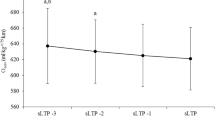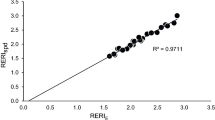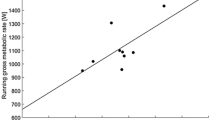Abstract
The purpose of this study was to assess the validity of v amax as an indicator of middle-distance running performance in sub-elite young runners, amax being defined as the quotient maximal oxygen uptake (V˙O 2max) divided by the net energy cost of running (C r) on a treadmill at a submaximal running velocity (280 m · min−1). The V˙O 2max, ventilatory threshold, amax, and C r were assessed in 39 young male sub-elite runners having only small variations in performance level. The relationship between each variable and running performance (at 1500 m, 3000 m, and 5000 m) was evaluated. A trend toward a negative correlation existed between C r and performance although this was not significant. The V˙O 2max and amax were significantly related to performance. The amax accounted for around 50% of the variability in performance whereas other physiological variables selected in this study were responsible, at best, for approximately 39%. The results presented in this study suggested that amax was a useful indicator of middle-distance running performance in sub-elite young runners with similar performance levels as well as in top elite athletes.
Similar content being viewed by others
Author information
Authors and Affiliations
Additional information
Accepted: 19 August 1997
Rights and permissions
About this article
Cite this article
Abe, D., Yanagawa, K., Yamanobe, K. et al. Assessment of middle-distance running performance in sub-elite young runners using energy cost of running. Eur J Appl Physiol 77, 320–325 (1998). https://doi.org/10.1007/s004210050340
Issue Date:
DOI: https://doi.org/10.1007/s004210050340




